Top Story: Health
Clearing the air, one city at a time
November 17, 2011
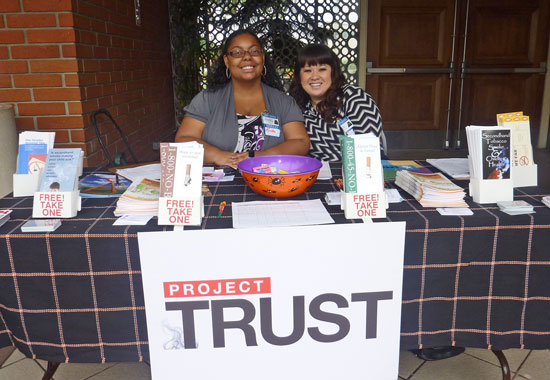
Public health workers Kristin McGuire, left, and Amber Tsujioka helped bring a new smoking ban to Compton.
Twenty-four years ago, when health advocates in Compton tried to restrict smoking, two City Council members defiantly lit cigarettes on the dais, then killed the plan before it could come to a vote.
We’ve come a long way, baby.
Last week, Compton passed a landmark ordinance to curb secondhand smoke in outdoor dining areas, parks, apartments and condos. Meanwhile, Hermosa Beach effectively outlawed outdoor smoking in virtually every part of the city where people gather.
On the other side of the 710 Freeway, the Downey City Council instructed staff to start drafting a law to restrict smoking in parks and other public places. This week, a tough, new, smoke-free housing measure was enacted in Baldwin Park.
The flurry of grassroots legislation—with more in the pipeline—isn’t accidental. For the past year and a half, the Los Angeles County Department of Public Health has been successfully leveraging a two-year, $16 million federal grant aimed at reducing smoking and exposure to secondhand smoke.
The initiative, known as Project TRUST and managed by the department’s Tobacco Control & Prevention Program, has been so successful that its efforts already have been extended under a new and broader Community Transformation Grant, underwritten by federal health care reform funding.
Although the Department of Public Health has long done educational campaigns to help communities discourage smoking, the federal money “has let us accelerate that work, and move into more challenging policy areas,” says Dr. Paul Simon, who heads the department’s Division of Chronic Disease and Injury Prevention. “We’re now getting into 10 or 15 cities a year.”
By law, the public health department cannot lobby, but it can educate the public, thus setting the stage for a community’s own advocacy. Under the grant, the county was able to hire six “community mobilization teams” and subcontract with nine community-based organizations to provide technical and educational support for local efforts to restrict smoking.
As the teams have fanned out in the past 18 months to do local polling, hand out literature and speak to community groups about tobacco, community activism has followed. Since the Project TRUST initiative hit the ground, local smoking ordinances have been revisited or broadened in Manhattan Beach, West Hollywood, Burbank, Los Angeles, South Pasadena, Santa Monica, Huntington Park, Torrance and Inglewood, as well as the aforementioned communities. Still other cities are in various stages of readying smoking ordinances for passage.
Particularly successful have been city-level efforts to cordon off no-smoking areas in apartment and condominium buildings, where secondhand smoke chronically plagues children and nonsmokers, particularly those with asthma. A recent policy brief from the UCLA Center for Health Policy Research found that nearly 1 million children in California are exposed to secondhand smoke every year.
Mandating smoke-free housing in apartment houses can be life-altering for families in rental units, but it has historically been a tough sell in lower-income areas, where smokers—who represent about 13% of California’s population—have tended to resist the notion that shared ventilation should keep them from lighting up in their own apartments.
A new state law that goes into effect Jan. 1 gives landlords the authority to ban smoking in rental units, but doesn’t mandate smoke-free apartments and condos. With the Compton and Baldwin Park votes last week, the county now has more than a half-dozen cities with smoke-free apartment ordinances, including Calabasas, which in 2006 pioneered the local movement.
And on November 16, Project TRUST will host a major policy forum on smoke-free apartments and condos in conjunction with the American Academy of Pediatrics and Children’s Hospital Los Angeles—a response to the growing number of local governments that are moving in that direction, says Project TRUST Director Robert Berger.
“It’s big,” says Berger. “We’ve reached a major tipping point in smoke-free housing here.”
Public health campaigns at all levels have for many years raised awareness of the dangers of tobacco, and state and federal restrictions have made dramatic inroads in the fight against tobacco-related illness. California was the first state to ban smoking in indoor workplaces in 1995.
But smoking still accounts for as many as 443,000 deaths a year nationally, including as many as 49,000 from exposure to secondhand smoke alone. According to the Centers for Disease Control & Prevention, more deaths are caused each year by tobacco use than by all deaths from HIV, illegal drug use, alcohol use, motor vehicle injuries, suicides and murders combined.
While overall smoking rates have been trending downward, higher smoking rates persist in a number of vulnerable sub-populations, including African American, Latino and Asian men, people with low income and education, the homeless, substance abusers and people living with mental illness.
In some policy efforts, such as the one that led to smoke-free housing in Pasadena, the county has played more of a supportive than lead role. In others, Project TRUST has collaborated with subcontractors such as the National Council of Alcohol and Drug Dependence South Bay or Smoke-free Air for Everyone (SAFE).
In most instances, the County’s technical and educational assistance has been welcome, but in a few, it has been met with confusion. When a City Council discussion of a ban in Downey drew a standing-room audience and a blizzard of letters, for instance, one councilman accused another of manufacturing “a sexy political issue for your campaign next year for the assembly.” Another was quoted in the local press as saying he had “never received a letter or comment on this until the last three weeks.”
Much more common, however, have been experiences like the one that will now set aside smoke-free apartments and condos in Compton, where the county’s mobilization team—a pair of young Public Health contract employees named Kristin McGuire and Amber Tsujioka—did most of the groundwork, beginning with a survey last year to assess the community’s level of concern about smoking.
As the pair became ubiquitous at PTA meetings, churches, community groups, senior centers and health fairs, the community began to coalesce in favor of smoke-free housing. Letters began to arrive at City Hall. High school kids began to show up around town in “Smoke-free Compton” t-shirts.
“A lot of the community members were unfamiliar with the impact of secondhand smoke,” says McGuire. “And when they would ask about possible solutions, we’d tell them how other communities were able to educate each other and form coalitions.”
It didn’t hurt that Compton City Councilwoman Yvonne Arceneaux had a longstanding interest in the dangers of smoking.
“I had led a movement a number of years ago to ban alcohol and tobacco billboards in the city of Compton,” says Arceneaux, “and I had had a bad experience with my daughter in an apartment situation. She’s a non-smoker with two small children and she had lived in Texas in an apartment below two smokers.
“It was coming through the vents, and for the first time in their lives, they were experiencing problems with asthma. It was horrible.”
Within six months of the county’s involvement, Arceneaux says, an ordinance was drafted, with technical help from the county.
McGuire, the Project TRUST mobilization team member, says her work in Compton has been “very rewarding” and hopes she’ll be able to continue working with the city as it implements its new ordinance.
Arceneaux, meanwhile, says the mood in Compton couldn’t be more different from that meeting in 1987. The measure passed easily, to the cheers of an audience full of teenaged Smoke-free Compton supporters. And so far, she added, no one’s complaining.
“I think this time the community was ready for it,” she says.
Posted 11/3/11
‘Tis the season for flu shots
October 20, 2011
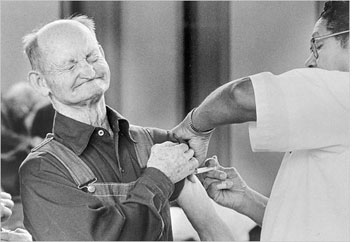 Flu season has officially begun in Los Angeles County, and the county’s Department of Public Health is urging that you get vaccinated as soon as possible.
Flu season has officially begun in Los Angeles County, and the county’s Department of Public Health is urging that you get vaccinated as soon as possible.
Four cases have already been treated for strains covered by this year’s vaccine, all from West Los Angeles and the San Fernando Valley. These officially mark the start of a flu season that is likely to last until May. says public health director Dr. Jonathan E. Fielding.
“Even healthy people can get very sick from the flu and spread it to others,” he says, recommending that everyone six months of age or older receive a flu vaccine every year.
Fielding urges residents to contact their doctors for a vaccine. Alternatively, low-cost vaccines also are available throughout the county at supermarkets and pharmacies. (Click here and then look for the blue “Flu Care” box along the right margin.)
Starting next week, the county also will offer free vaccines to people who do not have health insurance. Click here to search for a county flu clinic by ZIP Code and click here for a list of upcoming flu clinics throughout the county, or call the county Information Line at 2-1-1. And for a lot more information, click here.
Posted 10/20/11
Here’s the lowdown on West Nile scare
August 10, 2011
 Mosquitoes aren’t high on the list of seasonal worries in Los Angeles County. But with two new cases of West Nile virus confirmed here in recent days, the fear factor is rising fast.
Mosquitoes aren’t high on the list of seasonal worries in Los Angeles County. But with two new cases of West Nile virus confirmed here in recent days, the fear factor is rising fast.
“There shouldn’t be cause for panic,” says Dr. Jonathan E. Fielding, director of the county Department of Public Health. “But we do want to remind people to take appropriate precautions.”
For example, Fielding says, discourage mosquitoes from breeding near your home by getting rid of pools of stagnant water, and use a repellent containing DEET when you’re outdoors in mosquito-prone areas, especially around dawn or dusk.
The two victims reported this week in Los Angeles County were both middle-aged men, one in the San Gabriel Valley and the other in the San Fernando Valley. Both had pre-existing conditions,and both are recovering, Fielding says.
Though officials aren’t sure what has caused the spike in human cases, the good news is, most mosquitoes aren’t carriers of the virus, which is spread to humans from infected birds. And of the few people who do become exposed, says Fielding, only about one in 150 ends up in the hospital. The vast majority either suffer only minor flu-like symptoms or don’t get sick.
Still, eight human cases have been reported so far this year in five California counties and the virus can cause encephalitis and death in that rare minority. So here are some Department of Public Health recommendations:
- Avoid mosquito-infested areas at dawn and dusk.
- Wear long-sleeved shirts and long pants whenever you are outdoors.
- Repellants containing DEET, picaridin, or oil of eucalyptus, when used as labeled, are effective defenses against mosquitoes.
- Check your window screens for holes.
- Do not allow water to collect and stagnate in old tires, flowerpots, swimming pools, birdbaths, pet bowls, or other containers. These are prime breeding grounds for mosquitoes.
- Clean and chlorinate swimming pools; drain water from pool covers.
- Stock garden ponds with goldfish or other mosquito- eating fish. These eat mosquito eggs and larvae.
- Empty and wash birdbaths and wading pools weekly.
- If a recently dead bird (less than 24 hours) is found, call (877) 747-2243 for instructions on handling.
- Report “green pools” or stagnant swimming pools in Los Angeles County by calling the Public Health Environmental Health Bureau at (626) 430-5200.
- If you need more information on West Nile, call (800) 975-4448.
- For even more information, including statewide updates and local numbers to call if you have questions about mosquitoes, click here or here. For more on the disease itself, click here. And for advice from the Centers for Disease Control and Prevention, click here.
Posted 8/10/11
L.A. firehouse food brings healthy heat
May 17, 2011
 When President Barack Obama lunched earlier this month at a fire station in Midtown Manhattan, he sat down to pasta in cream sauce and eggplant parmesan—traditional New York firehouse fare. Too bad for his waistline he didn’t roll West Coast-style with Sheila Kelliher and her fellow Los Angeles County firefighters.
When President Barack Obama lunched earlier this month at a fire station in Midtown Manhattan, he sat down to pasta in cream sauce and eggplant parmesan—traditional New York firehouse fare. Too bad for his waistline he didn’t roll West Coast-style with Sheila Kelliher and her fellow Los Angeles County firefighters.
“We do a lot of grilling,” says Kelliher, a firefighter-paramedic at West Hollywood’s Station 8, where the take on firehouse cuisine is a far cry from the carb-heavy comfort fests dished up at fire stations in other parts of the country.
“Chicken, fish, pita breads, salads. Eleven years ago, when I first came on the job, it was meat and potatoes, but now healthier food is the trend. At least it is here.”
Kelliher should know. Last month, her quietly healthy recipe for Texas chili won the Barney’s Beanery First Annual Five-Alarm Firefighter Chili Cook-Off, a region-wide contest launched by the restaurant in honor of its 90th anniversary.
The recipe—a secret concoction of grilled tri-tip, red sauce, “no extra fat and not too many black beans”—was so delicious, yet light, that, starting June 1, it will appear on the Barney’s Beanery menu. Proceeds will benefit the Alisa Ann Ruch Burn Foundation, a nonprofit for burn survivors.
“Her chili was just very flavorful, it wasn’t too heavy and it wasn’t overloaded,” says the restaurant’s regional manager A.J. Sacher in a description that firehouse food experts say could easily sum up the philosophy of Southern California firefighters.
“In Chicago, they’ll grind up four pounds of meat and put in some macaroni and call it dinner,” says Jeff Gatesman, the West Los Angeles producer of “Feeding the Fire,” a web-based TV cooking show featuring firefighter chefs from across the country.
“But it’s a whole different story in California. We just shot an episode in Santa Monica and the guy made, like, pan-seared sea bass.”
Firehouse cooking is a venerable institution, particularly in cities where firefighters bunk in the fire station for 24-hour shifts that last several days.
“They work together, they sleep together and they break bread together,” says R.G. “Bob” Adams, author of “Firehouse Cooking: Food From America’s Bravest,” an international compilation of firefighter recipes that he says has sold more than a million copies since its first publication in 1993.
“The chef in a firehouse is the hub,” says Adams. “Kind of like the mother in a family.”
And like mothers everywhere, firehouse chefs are stewards of a community’s priorities and sub-cultures, from ethnic traditions to attitudes about nutrition and weight.
Long Beach Fire Capt. Eddie Sell, who is developing a cooking show for television called “Firehouse Chefs,” says that because firefighters have increasingly reflected the diversity of cities, firehouse meals “open the door to a city’s customs, so that when we have to make emergency calls to peoples’ homes, things aren’t as foreign.”
Where an East Coast firehouse might specialize in Italian feasts and a Southern company might be famed for rich desserts and gumbos, Sell says, West Coast stations will line up for pho and fish tacos.
“And definitely, there’s more heart-healthy stuff on the West Coast,” adds Matt Jackson, a West Covina firefighter-paramedic whose year-old Company Chow blog has become a recipe clearinghouse for firefighters from New York to Hawaii.
“Some crews I’ve worked on, the guys will have, like, gluten-free diets, or they’re not eating any simple sugars. Last year, ‘Live! With Regis and Kelly’ had a firefighter barbecue cook-off, and the California firefighter’s entry was actually a salad with barbecued pears.”
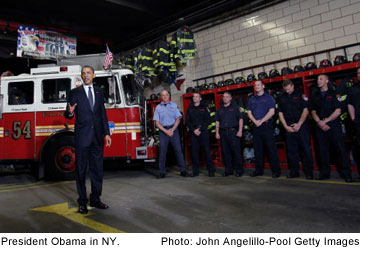 Kelliher, a Woodland Hills mother of 8-month old twins who does competitive bodybuilding in her spare time, says health is a priority at her station. (Check out one of her recipes here.)
Kelliher, a Woodland Hills mother of 8-month old twins who does competitive bodybuilding in her spare time, says health is a priority at her station. (Check out one of her recipes here.)
“Our county leads the charge when it comes to fitness,” she says. “We have a program called Fitness for Life. We have to pass a physical every year and meet certain benchmarks.
“And L.A. life is all about healthy lifestyle—a lot of our guys surf and snowboard and go to the river. Colder parts of the world, you don’t to do those things year-round, you’re covered up, maybe you eat more comfort food. But here, you hit the beach, the shirts come off and vanity kicks in.”
The 13 firefighters on her shift take turns at kitchen duty, she says: “Everybody puts in their money for chow—$12 for two meals, $7 for one meal—then whoever is the cook takes the money and goes to the store.”
All firehouse meals must meet two basic criteria, she says: “You can’t come up short, and it has to taste good.”
But health is a given, even for the younger firefighters who can eat as much bread as they want to. Grilling—which allows the fat to drip away from fish or meat during cooking—is such an art form at Station 8 that a few years ago, the whole crew chipped in and built an outdoor barbecue and grill station. “Everybody has their own specialty,” she says.
As for that special chili, she entered it in the contest at the behest of a friend, who knew it as something that Kelliher, who grew up in a family of Texas restaurateurs, served at Superbowl parties. Kelliher did her cooking off-duty and pressed her husband into helping her to serve massive quantities of the chili during the competition. It’ll be on the menu till September at all five of Barney’s Beanery locations in Los Angeles County.
Which may be the only chance her fellow crew members get to taste it. Ironically, she’s never served it at the firehouse. “It’s too labor intensive,” she said.
Posted 5/17/11
Side order of better service, please
May 12, 2011
George Abou-Daoud knows a thing or two about opening and operating a restaurant in this town—from a buzzed-about oyster bar/bistro to an old school Mexican-style cantina.
But with eight restaurants and six years in the business here, he’s mystified about one thing:
The county’s restaurant inspection process—especially when it comes to getting a new place off the ground.
“There is an unbelievable inconsistency in terms of what the different inspectors want you to do,” said Abou-Daoud, who’s preparing to launch the new Rosewood Tavern, which will join his other Hollywood restaurants including District, the Mercantile Wine Bar and Delancey Pizzeria & Bar. “Every possible way you can go about it, somebody’s got a different opinion.”
Then there are delays in plan approvals that can run well over the standard processing time of 20 days—and cost the restaurateur plenty as he pays rent on an unopened eatery. “When you buy a restaurant or lease a place, the clock is running,” Abou-Daoud said.
He’s not alone in his concerns. In response to such complaints, Los Angeles County Supervisors on Tuesday postponed until July 12 a vote on a Department of Public Health proposal to hike inspection fees for most restaurants—adjustments that the department says are necessary to cover its costs. (The department estimates that 72% of restaurants would pay more under the proposal, while the rest would pay less. In addition, in some cases fees would be assessed for services that are now free.) Before they approve any fee changes, the supervisors said, they want the department to come up with a plan for improving service, to get more input from the restaurant industry and to make the rationale for the proposed increases more transparent.
The board action came on a motion by Supervisor Don Knabe, who said that the fee hikes hadn’t been adequately communicated with “rate payers” in the industry who would be most affected. Amendments to the motion came from Supervisors Michael D. Antonovich and Zev Yaroslavsky.
Yaroslavsky said the department needed to speed up its plan check reviews, to offer “clear and consistent” interpretations of the food code and to rein in unprofessional behavior by some front-line inspectors. And it needs to do so without asking for additional resources.
“The problem with people at the lower end of the food chain is that some of them get a little carried away,” Yaroslavsky said, launching into a joke that Al Gore used to tell about crisscrossing the country during his presidential run and trying in vain to get a little extra chicken on his lunch plate during a picnic stop in South Carolina.
Gore asks for two pieces and is told that one is the limit. “And Gore said, ‘Do you know who I am? I’m Al Gore, and I’m running for President of the United States.’ The server said, ‘Do you know who I am? I’m the guy who serves the chicken.’”
Yaroslavsky said the Department of Public Health, along with other permit-issuing agencies, have some “little Napoleons running around who have a little bit of power, and they’re the people who serve the chicken.”
Dr. Jonathan E. Fielding, the county’s director of public health, agreed that the department could stand some improvements in the customer service department and could do more to integrate restaurant owners into the rate-setting process. He also said the department would post on its website a survey by an independent consultant that was used to establish the proposed increases, which would be the first since 2007. That survey measured the actual time it takes the department to perform each kind of inspection, and set the proposed fees accordingly—a more precise method than what was in place previously.
“We have to be very customer-sensitive and friendly while at the same time making sure that we enforce the state and local codes to protect the public health,” Fielding said.
Some restaurateurs say they’re afraid to complain about the process or about individual inspectors for fear of retaliation. But Fielding said they had nothing to fear, and should speak up about any problems. “If we don’t know about them, we can’t solve them,” he said.
As for Abou-Daoud—once described as a “mogul whose lounges are docked along Sunset Boulevard like ocean liners” by L.A. Weekly restaurant critic Jonathan Gold—he’s not griping about higher fees, as long they’re accompanied by improvements.
“Raise them—but offer something in return that saves us money on the back end,” he said.
Posted 5/12/11
The flipside of fun in West Hollywood
April 28, 2011
West Hollywood’s nightlife is legendary, drawing local and international crowds to hotspots ranging from The Abbey to The Roxy, with every conceivable kind of watering hole in-between.
But where there’s revelry, there may be a hangover, too. A recently-released public health report on problems associated with alcoholic beverage outlets in Los Angeles County found that West Hollywood has the highest concentration of on-premises drinking establishments anywhere in the county. It also ranked near the top in “off-premises” stores selling alcoholic beverages to go.
What’s more, the small, sophisticated city ranks third-worst among the 117 communities surveyed for motor vehicle crashes and 13th worst for violent crime. Its alcohol-related death rate also was deemed a serious enough problem to be ranked “high” among the communities included in the report.
“West Hollywood is, for better or worse, the adult playground of Southern California,” said Mayor John Duran. “It is primarily an adult community,” drawing residents and visitors alike because of its many dining, drinking and entertainment options. “It’s why we all choose to live here.” But, he noted, “there is a tradeoff.”
The popularity of the city’s restaurants, bars and hotels gives West Hollywood the budget to fund important services—even in tough economic times. “Without all that nightlife activity, we wouldn’t have a surplus,” Duran said.
The report, issued by the Los Angeles County Department of Public Health, seeks to draw connections between the density of liquor establishments and an array of problems ranging from car crashes and hospital admissions to neighborhood disturbances and assaults.
Nowhere are the issues and dilemmas more striking than in West Hollywood.
“While we are home to the Sunset Strip’s nightclubs, we are also a Mecca for recovery,” Daphne Dennis, the city’s social services manager, said in an email describing the city’s support for 12-step recovery efforts. Overall, she said, West Hollywood commits “substantial resources” to two strategies recommended in the report—access to mental health and substance abuse services and educational services. Other recommendations— on limiting advertising and on training for alcoholic beverage-selling staffs—are expected to be discussed by the city’s Human Services Commission in May.
The report used 2007 population estimates and information from the state’s Department of Alcoholic Beverage Control to determine the density of liquor outlets in individual communities. Then it analyzed law enforcement and health data to try to measure the impact of such establishments in each part of the county.
It found an average of 16 alcohol outlets per 10,000 people countywide. In West Hollywood, the concentration was far greater—47.3 on-premises outlets per 10,000 residents.
Still, the per-capita measurements of alcohol-related problems may not tell the whole story when it comes to West Hollywood—a 1.9 square mile city with 34,399 residents which has a much larger footprint after dark.
“Our city swells to over 100,000 on the weekend. Even on a weeknight, our population probably doubles,” said Lt. David Smith, of the Los Angeles County Sheriff’s Department’s West Hollywood station.
He said the department responds to the influx by taking a pro-active approach to all kinds of alcohol-related issues, including DUI enforcement.
Every holiday season, deputies and city staffers hand out cocktail napkins bearing an anti-drunk driving message to bars and nightclubs. And for the past several years, a wrecked car has been displayed prominently at the corner of Santa Monica and San Vicente boulevards from early December through New Year’s—a reminder of the consequences of having one for the road.
“We take drunk driving seriously,” Smith said, “and efforts are underway to counteract it.”
At Barney’s Beanery, a West Hollywood institution that’s celebrating its 90th anniversary Saturday, regional manager AJ Sacher said it makes good business sense to keep its clientele from drinking and driving.
“We call cabs all the time for our customers,” Sacher said. Barney’s, like other drinking establishments, also offers free non-alcoholic beverages for designated drivers and lets people who’ve overindulged leave their car valet-parked all night, without charge. “We want them to come back.”
Sacher said West Hollywood businesses tend to “operate in an extremely responsible manner” toward the drinking public—“It’s our livelihood.”
And he said he thinks the public as a whole has gotten savvier about drinking and driving in recent years.
“The vast majority of people who go out to restaurants in Los Angeles County every night are very responsible with their alcoholic beverage consumption, get home safely and don’t cause any problems.”
But when there are alcohol-related problems, the public health report found, they tend to happen where liquor-selling facilities are clustered.
And West Hollywood is not alone in feeling the effects.
On the Westside, Culver City, Santa Monica and Malibu also have high numbers of alcoholic beverage establishments per capita and have had their share of related problems, particularly motor vehicle crashes. (Beverly Hills, on the other hand, has one of the county’s highest concentrations of restaurants, bars and stores selling liquor, but has experienced only low levels of the social problems surveyed in the report.)
Elsewhere in the county, Commerce had the county’s highest concentration of stores selling liquor. It also had the worst rate of car crashes, the 2nd worst rate of alcohol-related deaths, and one of the worst violent crime rates. San Fernando, with a high proportion of liquor stores, had the worst rate of alcohol-related deaths. The correlation between liquor establishments and social problems wasn’t always quite so pronounced, though. For example, Westmont, an unincorporated area close to South Central Los Angeles, had the worst violent crime rate among the communities surveyed—but ranked only “medium” in the number of liquor stores.
“Obviously, there are always going to be exceptions,” said Ben Lee, chief of the research and epidemiology unit that crunched the data for the report. But overall, he said, the report should serve as an eye-opener for people and communities across the county, as well as a tool for policy-makers seeking to combat an array of ills associated with alcohol abuse.
Posted 4/28/11
New health report takes aim at alcohol
April 21, 2011
A newly released study by Los Angeles County’s Department of Public Health paints a grim picture of the rippling impact of alcohol sales and consumption across the region, disclosing, among other things, that close to 1 in 5 high school students reported at least one episode of binge drinking in the past month.
The report draws a direct correlation between communities with a high number of alcohol outlets and a variety of harms, including violent crime, motor vehicle crashes and alcohol-related deaths. These neighborhoods, mostly in poorer areas of the county, are up to 10 times more likely to have increased rates of violent crime and three times more at risk for alcohol-involved crashes, according to the study, called “Reducing Alcohol-Related Crimes in Los Angeles County.”
“Each year, 2,500 people in the county die from alcohol-related causes, with the loss of approximately 78,000 years of potential life,” Public Health Director Dr. Jonathan E. Fielding said in an introduction to the report. “In addition to the devastating personal and societal effects of alcohol abuse on individuals, families and communities, excessive alcohol consumption costs Los Angeles County an estimated $10.8 billion annually, or roughly $1,000 for every resident.”
Fielding said in an interview that he was particularly troubled by the high rate of binge drinking among younger people.
“They have less experience and don’t understand the limitations of what they can and cannot do,” Fielding said. “We already know they are risk-takers in the way they drive at higher speeds. It’s a very bad combination, one that every family should be concerned about. It’s very disturbing.”
The report, which examines the density of alcohol outlets in 117 communities and cities across the county, calls for a series of measures aimed at reducing alcohol availability and consumption.
Fielding specifically called for an increase in alcohol taxes through legislation or ballot initiatives. “We should be doing everything we can to reduce consumption,” he said. “We need to change the economics.”
California’s last increase in alcohol taxes, he said, occurred in 1991. The study states that only Louisiana, for example, has a lower wine tax than California.
For the complete study, including a community-by-community ranking of alcohol outlet density and related harms, click here.
Posted 4/21/11
New ER offers Rx for better care
February 16, 2011
For somebody who’s spent more than 20 years on the frontlines of life-and-death medicine, Johnnie Holmes was looking a lot like a kid in a candy store.
Holmes, a supervising charge nurse in the emergency room of Olive View-UCLA Medical Center, was breezing through the halls and treatment rooms of her new workplace this week and searching for adjectives to describe it all.
“Amazing,” “exciting” and “incredible” were all getting a workout.
After working in extremely cramped quarters to care for patients suffering from everything from gunshot wounds to gallstones, Holmes and her crew are about to start nursin’ large.
As in 31,000 square feet large—more than double the size of Olive View’s old emergency room. `
The new ER, unveiled at a ribbon-cutting ceremony on Monday, will begin serving patients on March 6.
Its 51 treatment areas include two “trauma/procedure rooms” for the sickest patients, seven rooms for cardiac patients and specialized rooms for obstetric-gynecological exams, eye problems and orthopedic needs.
The facility also features a separate isolation ward for patients with tuberculosis and other infectious diseases, as well as, potentially, victims of a bioterror attack.
In the new ER, tests such as CT scans, ultrasounds and basic lab work will all be done onsite, so patients won’t have to be transported across the hospital for such workups.
The ER’s gleaming new equipment includes a device called VeinViewer Vision, which uses light and digital imaging to allow nurses to, in effect, look through a patient’s skin to find a vein to insert an IV or to draw blood.
“This is an amazing machine,” Holmes said as she demonstrated the VeinViewer for visitors.
But it will take more than new technology to confront some of the ER’s biggest challenges. The ER’s patient load has grown by 15% over the past two recession-plagued years, from 40,000 patients to 46,000. That mirrors a trend seen in emergency rooms across the county recently, with high unemployment and people losing their health insurance.
A related issue is that Olive View’s ER, like other emergency rooms, has long waiting times–a problem the hospital has been working to address, with some success, even before the move to the new ER.
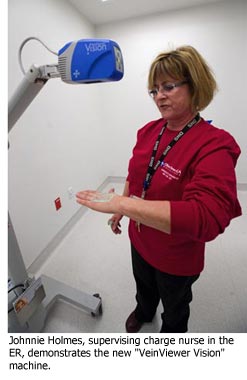 In the past 12 months, median wait times in Olive View’s emergency area dropped from just under three hours to just under two hours, despite the increased patient load, thanks to the addition of a physician to perform rapid medical screening exams. The overall length of stay for patients dropped from eight hours to seven. (Similar efforts to make sure the sickest patients are treated first are underway at other county facilities as well.)
In the past 12 months, median wait times in Olive View’s emergency area dropped from just under three hours to just under two hours, despite the increased patient load, thanks to the addition of a physician to perform rapid medical screening exams. The overall length of stay for patients dropped from eight hours to seven. (Similar efforts to make sure the sickest patients are treated first are underway at other county facilities as well.)
In hopes of continued improvement, Olive View officials are planning to add another nurse practitioner and to increase the physician staffing in the ER in the next four months, and have also hired a consultant to look at patient flow and staffing issues in the new space. They expect that greater efficiencies will come from having onsite labs and radiology, as well as a chest pain observation area and more versatile exam rooms and monitoring equipment.
Olive View is only public hospital serving the San Fernando, Santa Clarita and Antelope valleys, and is a key part of the county’s overall emergency services network. The new ER should allow Olive View to serve from 8,000 to 10,000 more emergency patients each year. The $53 million project, which started in 2002, finished nearly $1 million under budget and nine months early.
That’s good news for patients, who in addition to the long waits have gone without privacy and even beds, being treated in chairs or crammed into hallways on gurneys.
“We have the most incredible patients,” Holmes said. The new ER “is going to be less stressful for us and hopefully a lot less stressful for them.”
“You find yourself apologizing all the time,” she said. “All of the nurses go home with bruises on their thighs because they’re always running into gurneys. It will be amazing to have all that space.”
Holmes, 61, who worked for the folk rock duo Seals & Crofts (“Summer Breeze”) before becoming a nurse, now acts as a kind of air traffic controller in the ER, making sure the most urgent cases are seen first. In preparation for the new ER, she staged a scavenger hunt (with See’s truffles as prizes) to help nurses learn their way around the vastly larger space.
“It’s like a dream come true for all of us,” she said, even though she expects some “separation anxiety” among nurses who’ll be shifting from a single nursing station in the old ER to seven in the new space.
She said that–with the notable exception of the waiting times–public hospital emergency rooms provide care that equals or exceeds that offered in many private facilities.
“It always amazes me that people have a tendency to put down public hospitals. I’m here to tell you that, after being in private emergency rooms with my family members…they give the most amazing care here.”
The new emergency room is “first class,” said Supervisor Zev Yaroslavsky, who represented the Board of Supervisors at the inaugural event along with Supervisor Michael D. Antonovich. “The only thing missing right now is patients.”
Before the ribbon was cut, Dr. David Talan, chief of the hospital’s emergency medicine department, gave a shout-out to those patients. “Thank you for your trust. It’s an honor to help you…Above all else, the new Olive View emergency room is for our community and all of the people we are dedicated to serving.”
Talan also saluted his emergency department staff. “They’re here after everyone else goes home,” he said. “They have been doing their best under some very challenging circumstances.”
Posted 2/16/11







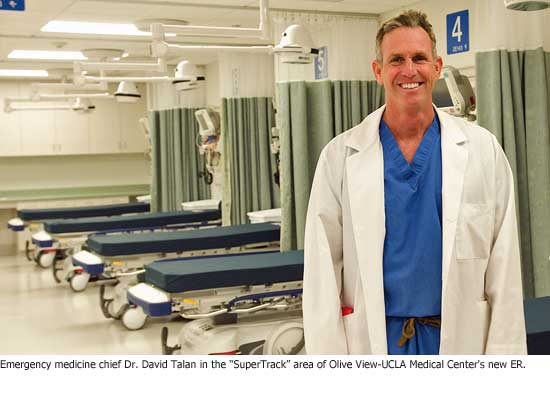







 405 bridge work causes a stink
405 bridge work causes a stink
